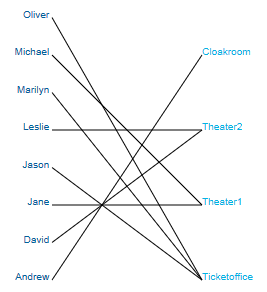distribute: Personnel planning
The director of a movie theater wishes to establish a plan with the working locations for his personnel. The theater has eight employees: David, Andrew, Leslie, Jason, Oliver, Michael, Jane, and Marilyn. The ticket office needs to be staffed with three persons, theater entrances one and two require two persons each, and one person needs to be put in charge of the cloakroom. Due to different qualifications and respecting individual likes and dislikes, the following constraints need to be taken into account:
- Leslie must be at the second entrance of the theater.
- Michael must be at the first entrance of the theater.
- David, Michael and Jason cannot work with each other.
- If Oliver is selling tickets, Marylin must be with him.
Model formulation
Let PERS be the set of personnel and LOC = {1,...,4} the set of working locations where 1 stands for the ticket office, 2 and 3 for entrances 1 and 2 respectively, and 4 for the cloakroom.
We introduce decision variables placep for the working location assigned to person p. The four individual constraints on working locations can then be stated as follows:
placeMichael = 2
all-different(placeDavid,placeMichael,placeJason)
placeOliver = 1 ⇒ placeMarylin = 1
We also have to meet the staffing requirement of every working location:
Implementation
For the implementation of the staffing requirements we may choose among two different constraints of Xpress Kalis, namely occurrence constraints (one per working location) or a distribute constraint (also known as global cardinality constraint) over all working locations. The following model shows both options. As opposed to the previous example (Section Implementation we now have equality constraints. We therefore use the three-argument version of distribute (instead of the version with four arguments where the last two are the lower and upper bounds respectively).
For an attractive display, the model also introduces a few auxiliary data structures with the names of the working locations and the corresponding index values in the set LOC.
model "Personnel Planning (CP)"
uses "kalis"
forward procedure print_solution
declarations
PERS = {"David","Andrew","Leslie","Jason","Oliver","Michael",
"Jane","Marilyn"} ! Set of personnel
LOC = 1..4 ! Set of locations
LOCNAMES = {"Ticketoffice", "Theater1", "Theater2",
"Cloakroom"} ! Names of locations
LOCNUM: array(LOCNAMES) of integer ! Numbers assoc. with loc.s
REQ: array(LOC) of integer ! No. of pers. req. per loc.
place: array(PERS) of cpvar ! Workplace assigned to each peson
end-declarations
! Initialize data
LOCNUM("Ticketoffice"):= 1; LOCNUM("Theater1"):= 2
LOCNUM("Theater2"):= 3; LOCNUM("Cloakroom"):= 4
REQ:: (1..4)[3, 2, 2, 1]
! Each variable has a lower bound of 1 (Ticketoffice) and an upper bound
! of 4 (Cloakroom)
forall(p in PERS) do
setname(place(p),"workplace["+p+"]")
setdomain(place(p), LOC)
end-do
! "Leslie must be at the second entrance of the theater"
place("Leslie") = LOCNUM("Theater2")
! "Michael must be at the first entrance of the theater"
place("Michael") = LOCNUM("Theater1")
! "David, Michael and Jason cannot work with each other"
all_different({place("David"), place("Michael"), place("Jason")})
! "If Oliver is selling tickets, Marylin must be with him"
implies(place("Oliver")=LOCNUM("Ticketoffice"),
place("Marilyn")=LOCNUM("Ticketoffice"))
! Creation of a resource constraint of for every location
! forall(d in LOC) occurrence(LOCNUM(d), place) = REQ(d)
! Formulation of resource constraints using global cardinality constraint
distribute(place, LOC, REQ)
! Setting parameters of the enumeration
cp_set_branching(assign_var(KALIS_SMALLEST_MIN, KALIS_MAX_TO_MIN, place))
! Solve the problem
if not(cp_find_next_sol) then
writeln("Problem is infeasible")
exit(1)
end-if
! Solution output
nbSolutions:= 1
print_solution
! Search for other solutions
while (cp_find_next_sol) do
nbSolutions += 1
print_solution
end-do
! **** Solution printout ****
procedure print_solution
declarations
LOCIDX: array(LOC) of string
end-declarations
forall(l in LOCNAMES) LOCIDX(LOCNUM(l)):=l
writeln("\nSolution number ", nbSolutions)
forall(p in PERS)
writeln(" Working place of ", p, ": ", LOCIDX(getsol(place(p))))
end-procedure
end-model
Since we merely wish to find a feasible assignment of working locations, this model first tests whether a feasible solution exists. If this is the case, it also enumerates all other feasible solutions. Each time a solution is found it is printed out by call to the procedure print_solution.
Results
This problem has 38 feasible solutions. A graphical representation of a feasible assignment is shown in Figure Personnel schedule representation.

Figure 3.2: Personnel schedule representation
The following Mosel code was used for generating the graphic (see the documentation of module mmsvg in the Mosel language reference manual for further explanation).
! **** Solution printout and graphical display ****
procedure draw_solution
svgerase
svgaddgroup("PersGraph", "Personnel")
svgsetstyle(SVG_TEXTANCHOR, "end")
svgaddgroup("LocGraph", "Locations")
svgaddgroup("AsgnGraph", "Assignments", SVG_BLACK)
forall(d in LOCNAMES)
svgaddtext("LocGraph", 4, LOCNUM(d), d)
FACT:=LOCNAMES.size/PERS.size
idx:= 1
forall(p in PERS, idx as counter) do
svgaddline("AsgnGraph", 2, idx*FACT, 4, getsol(place(p)))
svgaddtext("PersGraph", 2, idx*FACT, p)
end-do
svgsetgraphscale(75)
svgsetgraphviewbox(0,0,5,LOCNAMES.size+1)
svgrefresh
! Uncomment to pause at every iteration:
if nbSolutions<MAXSOL then svgpause; end-if
end-procedure
© 2001-2019 Fair Isaac Corporation. All rights reserved. This documentation is the property of Fair Isaac Corporation (“FICO”). Receipt or possession of this documentation does not convey rights to disclose, reproduce, make derivative works, use, or allow others to use it except solely for internal evaluation purposes to determine whether to purchase a license to the software described in this documentation, or as otherwise set forth in a written software license agreement between you and FICO (or a FICO affiliate). Use of this documentation and the software described in it must conform strictly to the foregoing permitted uses, and no other use is permitted.

